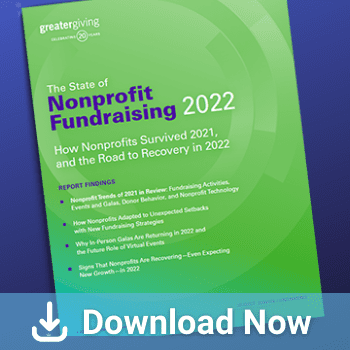
There was no playbook for planning a fundraising event during a pandemic. Now two years in, nonprofits need to be prepared for anything.
Once upon a time, much of the nonprofit industry leaned on annual in-person benefit events to meet budget requirements. Then the pandemic revealed some critical gaps in our standard fundraising strategies. Luckily, nonprofits took what they’d learned in 2020 and pursued new revenue streams like text-to-donate, holiday telethons, and micro-philanthropy campaigns.
The newly published State of Nonprofit Fundraising report found that many nonprofits still had to postpone or cancel fundraising events last year, and 44% of nonprofits reported falling short of their revenue goals. 81% of nonprofits said they are still feeling the negative impact of the pandemic on their day-to-day operations.
TIP:
Read The State of Nonprofit Fundraising 2022 in full here for more insights from 2021, and critical fundraising information for planning a fundraising event this year!
If there’s one takeaway from the last two years, it’s that we don’t know what comes next. Smart fundraisers should be looking back at the ups and downs of the last two years as a guide for holding events in the future—and taking steps to be prepared. That means having a backup plan, and knowing how to use it.
An Easy “Rainy Day Plan” for Your Fundraiser
Some nonprofits were ahead of the curve last year and hosted “hybrid-style” events, where virtual attendance was built into the plan alongside a live event. This allowed them to reach more new donors than ever before—but designing two separate event programs is unrealistic for many fundraisers.
Preparing a solid event alternative doesn’t have to cost time and money. Most of the tools are already in your arsenal; anything else is a great opportunity to invest in your nonprofit’s long-term fundraising success.
Use an online bidding platform.
Even if you’re only planning to host in-person guests at your event, letting them bid in the auction from a mobile device helps everyone.
Attendees can browse auction items in advance, and bid at any time, from any place in the event—which really drives up bids! Volunteers can check in guests easily, and with Greater Giving, skip the long line. Then staff and event directors simply submit their credit card charges. With mobile bidding, your auction is 100% prepared to go online in case of an emergency.
Hold in-person events at outdoor venues.
Throughout the pandemic, gathering in the open air is often the simplest solution to health and safety requirements. The same has proven true for fundraising events! Golf events, open air luncheons, and attraction- or experience-based fundraisers usually survived when other fundraisers had to shutter.
Capitalize on what makes your nonprofit unique, and plan an outdoor experience around it! For one Greater Giving client, The Woodland Park Zoo, holding a fundraiser in a zoo was both perfectly in-character, and easier to adapt to changing guidelines and restrictions. Other nonprofits have offered tours in small groups, fun outdoor activities, sports competitions, and peer-to-peer fundraisers like walk-a-thons.
Choose caterers and vendors who can pivot with you
It can be tough to make a major change to a fundraising event when nonprofits need to reserve vendors and pay deposits in advance. Ask potential vendors how they would handle a change. Find partners for your live production who are capable of going virtual or contact-free.
Some nonprofits have seen major success by providing a similar dinner-and-wine experience to guests, directly to their homes. Big Brothers Big Sisters Houston’s traditional annual fundraiser offered guests a memorable culinary tasting experience for virtual guests by delivering cuisine to their homes.
Use video and sound production to plan ahead for your event.
If your nonprofit already uses professional video production or audio-visual services, offer online guests the chance to watch the live event from home. For many nonprofits, the added cost of streaming an event to virtual attendees has paid off by expanding visibility, and bringing passionate new donors to the cause.
Now you have the structure already in place to bring remote guests into the atmosphere of giving. Any in-person guest can join as a remote guest instead—a great Plan B if something at your live event goes wrong.
Prepare for uncertainty with pre-recorded video. You never know who’s going to get sick at just the wrong time—like an emcee the night before a big event.
Plan ahead by pre-recording key sections of your program to boost the “wow” factor of your live event. Video can act as a critical backup measure for unplanned absences or quick transitions to online-only.
So what’s your backup plan? Please tell us in the comments!


One Response to “Planning a Fundraising Event? You Need a Plan B.”